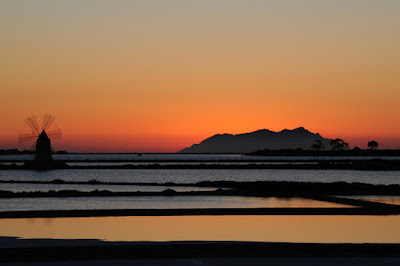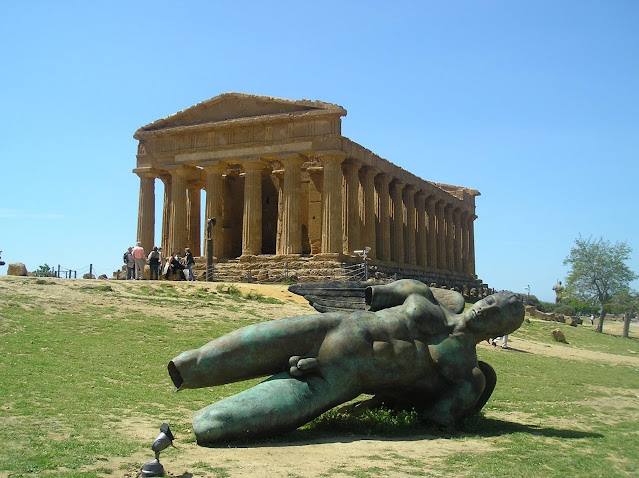Sicily's Gourmet Salt
"You are not truly at home in Sicily until you have consumed seven handfuls of salt with your meals"
an old Sicilian proverb
Human beings need salt to live, not because it is an essential seasoning but in moderation it regulates the body's water supply and Ph balance. The sodium contained in salt ensures that nerves and muscles respond properly. Chloride contributes to the formation of stomach acid and is of critical importance in the absorption of nutrients.
I can remember one time watching my adopted Sicilian big brother spread salt on half a lemon with a knife and then eat it.
Eeeeeeeeeeek ... that was one part of Sicilian life I did not want to indulge in.
About 30 per cent of table salt is derived from sea water and the remainder from subterranean salt deposits and salt works.
Foodies swear by the intense flavour of sea salt, which is considered better for our health. However, most sea salt contains less than 2 per cent of important minerals such as calcium and magnesium and have negligible health benefits. Natural sea salt does not contain enough iodine to meet human needs and, like other salt, should be iodized. The iodine contained in sea water evaporates along with the water during the crystallization process.
In antiquity, salt or 'sale', was considered a gift and a food of the gods. This 'white gold' was expensive and Roman Legionnaires and officials received part of their salaries in salt which is where the word 'salary' derives from.
Over the course of centuries, Sicily has been a centre of salt production. It began on the island with the Phoenicians and then it flourished in Roman times. The Arabs built more than thirty salt evaporation ponds in the west of the island between Trapani and Marsala in the 15th century which were the largest in Europe at that time. Today the landscape is still dominated by these salt pans and their windmills that were used to pump the sea water and grind the salt. In each mill an Archimedes screw was powered by the force of the rotating vanes, controlling the water and at one time the grinding of the salt as well.
The Trapani and Pacaco Saltworks are now a nature reserve and a World Wildlife Fund (WWF) reserve. About 170 species of birds live here, including flamingos, storks and herons who feed on the fish in the basins and lagoons.
At one time there were around 100 mills enjoying prosperity under the Spanish House of Aragon. The salt was even exported to Norway to preserve dried cod. In the middle of the last century one saltwork after another was forced to close for financial reasons, finally giving way to refineries in 1984. These developments drew environmentalists to the scene who became involved in the preservation of this unique landscape and in the reopening of at least some of the saltworks and windmills. Today about half of the previous surface area is in operation again and unlike other Italian saltworks here much of the work is still done by hand.
A salt museum is housed in the three hundred year old Salina di Nubia salt house. The museum displays tools that were used for mining salt in centuries past and features an exhibit that illustrates the salt mining process. The museum owner proudly shows his visitors his extensive collection and occasionally offers guests a simple saltworkers meal of bread with sardines, tomatoes, cheese, olives, wine and naturally salt. Saltworkers would have once carried buckets of salt weighing 30 Kg cushioned by pillows on their shoulders. They wore belts with wooden pegs and holes to note the number of buckets they filled. When they would reach 24,000 buckets, they would sing a hymn of thanks to God for Il Sale di Sicilia.
When exposed to sun and wind sea water evaporates and crystalline salt remains. This traditionally occurs in the shallow pools. First clean sea water is conveyed into a large pool. After the initial evaporation it is drained into a shallower neighbouring pool and from there it is pumped into even smaller pools from which it further evaporates. In about three months, moist, coarse salt crystals remain. They are stripped off the floor of the salt evaporation ponds with a special tool then piled up into a conical shape and dried in the sun. In the old salt mills the dried salt crystals are then ground into table salt. Collected in the summer, the salt is left to dry out in piles over the winter like snow drifts which are protected by terracotta tiles to maximise humidity.
In the south of Sicily Realmonte is most famous for the Scala dei Turchi which is a rocky cliff. The Scala, meaning stairs, are formed by marl a sedimentary rock with a characteristic white colour. It lies between two sandy beaches and is accessed through a limestone rock formation in the shape of a staircase, hence the name. The latter part of the name derives from frequent raids carried out by the Moors who used the rocks like steps to invade Sicily. Whilst this is a popular tourist attraction what some people do not know is that Realmonte is also known for another reason, its salt cathedral. Yes that's right a cathedral carved out of salt.
Approximately 2.5 Km from Realmonte you will find the Realmonte Salt Mine that together with other mines at nearby Racalmuto and that of Petralia Soprana in the Nebrodi Mountains, is one of three Sicilian salt mines still active. The mine is renowned for the quality of the mineral extracted from it which is an excellent cooking salt.
The length of its multi-storey salt tunnels, that are an astounding 62 miles, twist underground and are quite impressive with incredible black and white patterns on the walls formed by layers of salt deposits and erosions. What makes this salt mine more impressive than the others is the presence of the "Cathedral of Salt", a church which is one of a kind. Among the works of interest in the church is an altar sculptured into a big block of salt, the pulpit which is also sculpted in a block of salt and the Bishop's seat. The wall that closes the apse is sculpted with a low-relief portraying Saint Barbara who is the protector and patron saint of underground workers and whose saint day is remembered in a mass every 4th December in the church. The left wall features a low-relief of Jesus on the Cross, while on another wall there is one of the Holy Family, again all created in salt. Arranging a visit to the salt mine and its cathedral can be quite challenging and you need to apply for your visit well before your trip to Sicily and cross your fingers and hope to get lucky.
Salt is used widely in Sicilian cuisine, in particular baking in a salt crust. Baking with a protective salt crust is especially suitable for whole fish that are large and have firm meat such as sea bream, sea bass, grouper and turbot. This cooking method keeps the fish juicy and tender. Because the salt crust evenly distributes the heat so overcooking is avoided. While steaming in the protective coating the Sicilian herbs and spices that you can include in the salt paste, as well as minerals contained in the sea salt, add an optimal flavour to the fish.
When in Sicily a visit to Trapani is a must see on the western side of the island. Its salt pans have created an unforgettable bleached landscape. The western side of Sicily boasts incredible sunsets with a molten Sicilian sun which crashes into the sea casting the salt pans with a pink hue that sits beautifully against the ancient windmills with flamingos wading through the lagoons. Probably the setting for one of the most beautiful sunsets in the world.
For stunning views drive or cycle the 'Via del Sale', the Salt Road that runs between Trapani and Pacaco.
Trapani is the last stop before Africa. Greek mythology says that this ancient seafaring town was founded when the Titan Cronos castrated his father Uranus, the Greek god who personified the sky, and threw his genitals into the sea. Author D H Lawrence described it as a place still waiting for the Crusaders to call once more on their way to the East.
The city of Trapani has many monuments and places of interest in the old town which are vestiges of Spanish, Baroque and Moorish influence adorned with palm trees. The town itself, once enclosed by defensive walls, is a network of interconnecting narrow streets stretching across the peninsular to the sea. Today it is renowned for its seafood and cuisine and is also the main ferry port for crossings to the fascinating Egadi Islands.
I hope you have enjoyed reading my 'salty' Blog post.
You can find a wealth of Sicilian Travel Tips and
Sicily Trip Advice in my Blog archive,
Simply click on the Menu bar.
Sicily Trip Advice in my Blog archive,
Simply click on the Menu bar.
Photo Gallery
(Photo credits: Google Images)
Have you tasted Birra Messina Cristalli di Sale?
This new beer from Birra Messina has a pinch of Sicilian salt crystals, the salt gives the beer softness, roundness and a refined flavour evoking the dazzling light of Sicily's salt mines bringing to your mind the Sicilian sea, even the bottle has been specifically designed with an iconic shape and embellishment with reliefs that are further homage to the Sicilian baroque style, from which the design draws its inspiration, we love it and it is the perfect summer beverage to cool you down in the Sicilian heat.
Thank you for following me at
White Almond Sicily BlogSpot
I am also a contributor to
For NEW Blog updated and all things Sicilian
You can also follow me on
Facebook www.facebook.com/whitealmondsicily/
Twitter www.twitter.com/sicilyconcierge/
Instagram www.instagram.com/whitealmondsicily/
For Travel Tips, Trip Advice and Recommendations
Email me at WhiteAlmondSicily@Gmail.Com
Love Sarah and Daisy
💙💙💙














